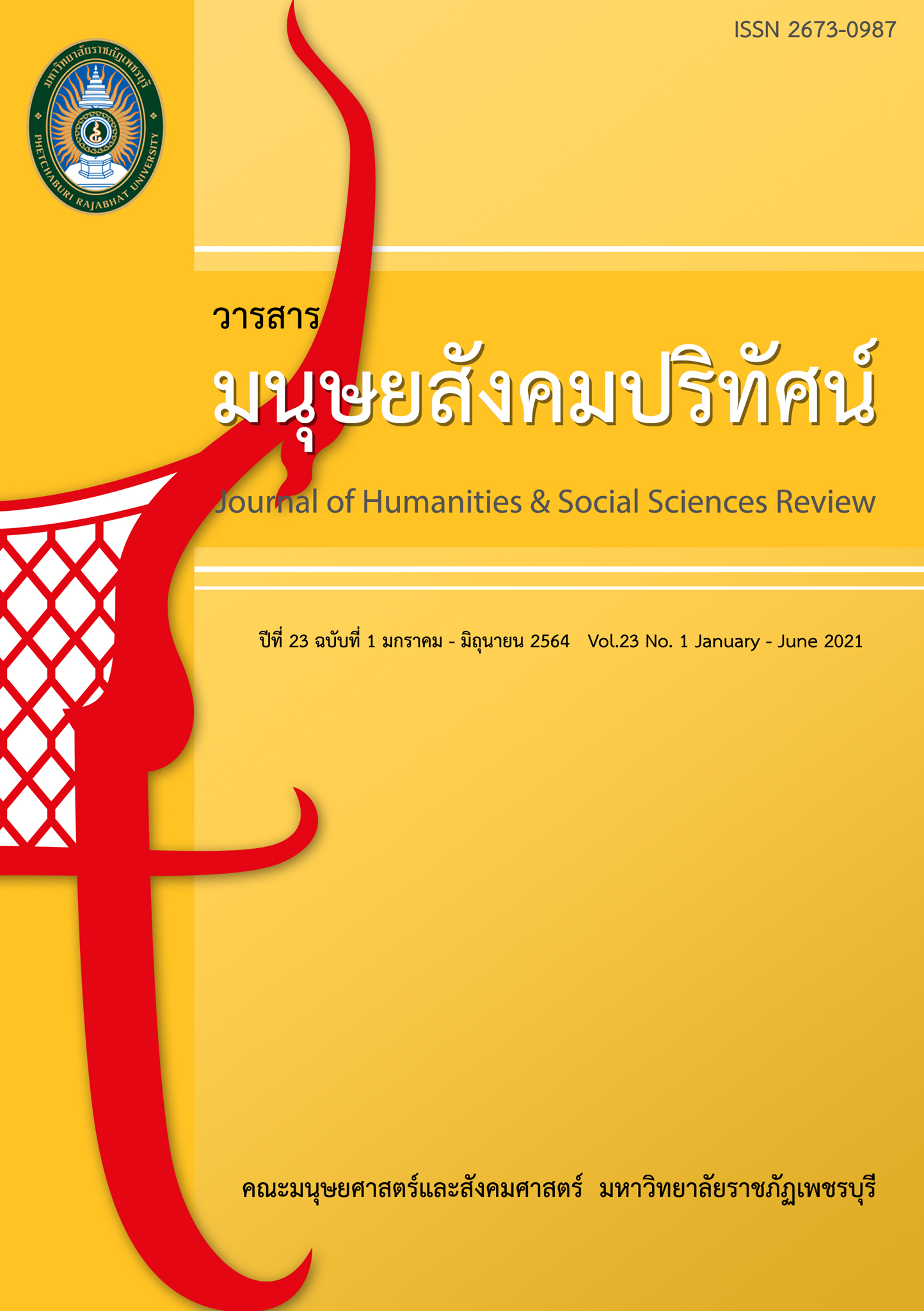Communication for Creative Tourism Development through Community Participation in Phetchaburi Province
Main Article Content
Abstract
The purposes of this research were 1) to study the potential of the communities in Phetchaburi province that can be developed to create added value and promote creative tourism in Phetchaburi province, 2) to study the method of communication and the use of mass media in the communities in order to develop the creative tourism in Phetchaburi province, and 3) to develop a framework for community participatory communication in order to promote the creative tourism development in Phetchaburi province. This research was a qualitative research using documentary research method, non-participatory observation, in-depth interviews, and group discussions. The data were collected from 30 people who involved with the tourism in the community.They were the key informants of community tourism management in Phetchaburi Province, consisting of 3 groups: representatives from government agencies, representatives from private tourism operators, and representatives from local communities. The results of this research were as follows: 1) The potential of the community that could be developed to create added value and promote creative tourism in Phetchaburi province consisted of 3 parts which were (1) The 4 key components of the community potential including natural resources and culture, community organization, management and learning, (2) community potential analysis on its strengths, weaknesses, opportunities, and obstacles - it was found that the community had beautiful natural resources, convenient routes to access the community, the unique local arts and culture, and the community leaders were strong and they played an important role in tourism development, and (3) creating value-added of the community- it was found that the tourism promotion committee has been established in which the people in the community were involved in the formulation of tourism promotion plans, creating value-added as cultural operators of the community, and creating community cultural maps to help promote tourism. 2) Community communication and media used for creative tourism development in Phetchaburi province consisted of 3 parts which were (1) the elements of communication including sender, message, media, and receiver, (2) the form of communication including informal two-way communication, formal two-way communication, informal one-way communication, and participatory communication, (3) the use of community media including personal media, traditional media, specialized media, mass media, and internet media. 3) Guidelines for participatory communication in the community for creative tourism development in Phetchaburi province consisted of 4 basic factors including, natural resources and culture, community organization, management, and learning. Those factors had been driven by communication elements, including the messenger, the media and the receiver, in order to gain the potential of the community with 3 main agencies as the driving mechanism, namely the community, government agencies, and the private sector under participatory communication, which was considered the heart of the important mechanism driving the conceptual framework by the name "Tao Tan Model"
Article Details
1. Any views and comments in the article are the authors’ views. The editorial board has not to agree with those views and it is not considered as the editorial board’s responsibility. In case, there is any lawsuit about copyright infringement, it is considered as the authors’ sole responsibility.
2. The article copyright belonging to Faculty of Humanities and Social Sciences, Phetchaburi Rajabhat University are copyrighted legally. Republication must be received direct permission from the authors and Phetchaburi Rajabhat University in written form.
References
2. กระทรวงการท่องเที่ยวและกีฬา. (2560). ยุทธศาสตร์กระทรวงการท่องเที่ยวและกีฬา ฉบับที่ 4 (พ.ศ. 2560 - 2564). ค้นเมื่อ 15 มกราคม 2562, จาก http ://www.mots.go.th/download/article/article_ 20171201174031.pdf .
3. กาญจนา แก้วเทพ และคณะ. (2543). สื่อเพื่อชุมชน: การประมวลองค์ความรู้. กรุงเทพฯ: สำนักงานกองทุนสนับสนุนการวิจัย.
4. กาญจนา แก้วเทพ. (2551). การจัดการความรู้เบื้องต้นเรื่องสื่อสารชุมชน. กรุงเทพฯ: สำนักงานกองทุนสนับสนุนการวิจัย.
5. กรวรรณ สังขกร. (2557). การพัฒนาศักยภาพชุมชนวัฒนธรรมสร้างสรรค์เพื่อสนับสนุนเชียงใหม่เมืองสร้างสรรค์. เชียงใหม่: สถาบันวิจัย มหาวิทยาลัยเชียงใหม่.
6. คณะกรรมการนโยบายการท่องเที่ยวแห่งชาติ. (2554). แผนพัฒนาการท่องเที่ยวแห่งชาติ พ.ศ. 2555 – 2559. กรุงเทพฯ: ผู้แต่ง.
7. เทิดชาย ช่วยบำรุง. (2552). บทบาทขององค์กรปกครองส่วนท้องถิ่นกับการพัฒนาการท่องเที่ยวอย่างยั่งยืนบนฐานแนวคิดเศรษฐกิจพอเพียง. กรุงเทพฯ: สำนักพิมพ์คณะรัฐมนตรีและราชกิจจานุเบกษา.
8. นำชัย ทนุผล และคณะ. (2543). รายงานผลการวิจัยการพัฒนาธุรกิจการท่องเที่ยวเชิงนิเวศน์ในชุมชนบ้านโป่ง ตำบลป่าไผ่ อำเภอสันทราย จังหวัดเชียงใหม่. กรุงเทพฯ: สำนักงานกองทุนสนับสนุนการวิจัย.
9. บุญเลิศ จิตตั้งวัฒนา. (2548). การพัฒนาการท่องเที่ยวแบบยั่งยืน. กรุงเทพฯ: เพรสแอนด์ดีไซน์.
10. พจนา สวนศรี. (2546). คู่มือการจัดการท่องเที่ยวชุมชน. กรุงเทพฯ: โครงการท่องเที่ยวเพื่อชีวิตและธรรมชาติ.
11. มุทริกา พฤกษาพงษ์. (2554). เที่ยวอย่างเข้าใจไปกับ“การท่องเที่ยวเชิงสร้างสรรค์”. ค้นเมื่อ 15 มกราคม 2563, จาก http://www.manager.co.th.
12. สำนักงานจังหวัดเพชรบุรี. (2557). แผนพัฒนาจังหวัดเพชรบุรี (พ.ศ. 2557- 2560). เพชรบุรี: กลุ่มงานยุทธศาสตร์การพัฒนาจังหวัด.
13. สินธุ์ สโรบล. (2546). การท่องเที่ยวชุมชน แนวคิดและประสบการณ์พื้นที่ภาคเหนือ. เชียงใหม่: สำนักงานกองทุนสนับสนุนการวิจัย.
14. Muganda M. (2009). Community and participation in tourism development in Tanzania. Thesis Degree of Master of Tourism Management, Victoria University of Wellington.
15. Raymond, C. (2000). The practical challenges of developing creative tourism: A cautionary tale from New Zealand ln Wurzburger, R., Aageson, T., Pattakos, A., & Pratt, S. (Eds.) Creative tourism: A global conversation (pp.63-69). New Mexico: Sunstone Press.
16. Richards, G. (2019). Creative tourism: Opportunities for smaller places. Tourism & Management Studies, 15(SI): 7-10.
17. Haget, S. (2009). Barriers for tourism sustainability in destination. M. A. European Tourism Management Bournemouth University Universidad Rey. Juan-Carlos: Madrid.
18. World Travel & Tourism Council. (2017). Travel & tourism economic impact 2017. London: author.


